Abstract
The objective of this research was to formulate a cream for the treatment of cracked heels using mustard oil as a key ingredient. The cream formulation, comprising mustard oil, wax, turmeric, coconut oil, camphor ,was prepared and evaluated for various parameters including irritancy, Spreadability, stability, after-feel, and Washability. The results indicated that the developed cream, enriched with mustard oil, exhibited safety, effectiveness, and satisfaction in the treatment of cracked heels. This conclusion suggests that the formulated cream, devoid of irritancy and possessing anti-inflammatory, analgesic, and moisturizing properties, holds promise for skin protection and cracked heel treatment.
Keywords
Heel Repair Cream, Turmeric, mustard oil, Camphor, Coconut oil
Introduction
The skin is the body’s largest organ, covering an area of approximately 20 square feet (about twice the size of a bath). It comprises three layers: the epidermis, which forms a waterproof barrier and determines our skin tone; the dermis; and the subcutaneous tissue. Cosmetics are widely used to maintain and enhance the natural appearance of the face, skin, eyes, hair, hands, etc. Herbal cosmetic products contain active bio-ingredients, nutraceuticals, and pharmaceuticals. They are used for cleansing and beautifying the skin. The earliest recorded use of cosmetics dates back to the Egyptians in 4000 B.C. Pharmaceuticals are primarily drug products that prevent, alleviate, treat, or cure diseases and affect the structure or function of the body. The skin on the feet is often dry, rough, and chapped because there are no oil glands present. T[1,2,3]his dryness can lead to cracking. Factors such as lack of moisturization, excessive exposure to pollution, and certain medical conditions like eczema, diabetes, thyroid disorders, and psoriasis contribute to dry and cracked feet.[4]
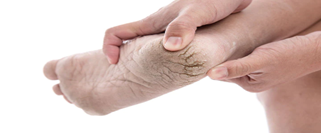
The skin on our feet is naturally dry, unlike the skin on the rest of the body, as it lacks oil glands and relies on hundreds of thousands of sweat glands to maintain moisture. Dry feet can vary in severity from mild, temporary dryness to severe dryness leading to additional issues. There are various reasons for dry skin, but preventive measures include regular moisturizing and avoiding rubbing or scratching. Cracked heels are typically more prevalent among elderly women compared to young girls.[5]
Causes :
Cracked heels have no age limit and can affect anyone regardless of sex, colour, or origin. Most of the time, cracks are occupational, such as farming or jobs that demand continuous standing. Age, walking on uneven surfaces, prolonged standing on hard floors, uncomfortable or ill-fitting footwear, unhealthy diet, obesity, diabetes, psoriasis, and other skin allergies, unhygienic conditions of the feet, or high exposure of feet to fine particles dirt, microbes, etc., are common causes.
Definition :
Creams are semisolid dosage forms intended for topical application to the skin, placement on the surface of the eye, or use nasally, vaginally, or rectally for therapeutic, protective action, or cosmetic function. These preparations are utilized for the localized effects produced at the site of their application by drug penetration into the underlying layer of the skin or mucous membrane. These products are designed to deliver drugs into the skin in treating dermal disorders, with the skin as the target organ. [6]
Creams are semisolid emulsion system with opaque appearance as differentiated with translucent treatments. Cream is utilized for external purpose. Creams are aiming for application to the skin and mucous layer. Their consistence depends on whether the,
- Emulsion is water in oil or oil in water.
- Nature of solids in inside phase.
Skin care creams can be classified on different basis :
- According to function. E.g. cleansing, foundation, massage etc.
- according to characteristic properties, e.g. cold creams vanishing creams etc.
- According to nature or types of emulsion.
- Skin nourishment and required to protect the typical characters of the skin or as a treatment for dry skin.[7]
Materials:

1. Bees wax
Beeswax is utilized broadly in the manufacture of beauty care products, essentially as a thickener utilized in occlusive. When combined with an fixing such as borax, it acts as an emulsifier. Beeswax can be utilized to modify a cosmetic product’s physical properties, such as to increment a lipstick’s gloss and hardness, improve its color and tactile characteristics, and progress its application characteristics.[8]
2. Mustard oil
Mustard oil Have Anti-inflammatory, Pain relieving, Antimicrobial, Antifungal and Antibacterial properties. Which is helps to diminish inflammation, pain, block microbial growth, prevent fungal infections and battle bacterial diseases. Other properties or benefits like progress circulation, boosts your appetite, promote sweating, avoids mucus and too utilized as tonner. Mustard oil contains a high amount of selenium and magnesium, which gives it anti-inflammatory properties [9]
3. Coconut Oil
For thousands of a long time tropical nations have utilized coconut from the tree Cocos nucifera, Family Aracaceae (palm family) as an necessarily portion of their diet and livehood Known as “kalpa vriksha”, in Sanskrit, this translates as the palm which supplies all the necessities of life. The coconut is known as “pokok seribu guna” in Malaysia, deciphering as a tree of a thousand employments. In Philippines, it is commonly known as the “Tree of Life”. All parts of the coconut palm are valuable, with critical financial value. Coconut oil used as moisturiser[10]
4. Camphor
Camphor (topical) recommended employments incorporate treating pain, warts, cold bruises, haemorrhoids , osteoarthritis, anti-itch, to increment nearby blood stream, and as a counterirritant. Camphor is an FDA-approved topical antitussive (anti-cough). Camphor is an FDA-approved topical pain relieving and anaesthetics utilized to diminish pain.[11]
5.Turmeric
Turmeric is one of the plants that has been conducted investigate testing as a treatment of illnesses herbally. The common open employments turmeric as a cooking flavour. The fundamental substance possessed by turmeric is curcumin (77%), demetoksik (17%) and bisdemetoksik (3%). Turmeric extract is one of the research samples about tests that has a parcel of potential to overcome disease such as cancer prevention agents, anticancer, anti-inflammatory, antiallergenic and antidiabetic[12]
6. Rose oil
Essential oils as well as their separated compounds are broadly utilized in cosmetic items as they offer a assortment of benefits. Their biological activties range from pain relieving, antiseptics, antimicrobial, carminative, diuretic , spasmolytic to hyperaemic and stimulatory. The primary reason for their utilization in beauty care products is their wonderful smell. Greasy acids, greasy oils and surfactants utilized in the production-process of restorative items frequently display an repulsive fragrance. Viable aroma blends are in this manner included to these items in arrange to veil it. If such a item is not unequivocally named as “fragrance-free”, “contains no perfume” or “scented-free” it can be accepted that it contains scent chemicals[13]
Method:
Extraction of curcumin :
cleaned, washed with deionised water, sliced and dried in the sun for one week and dried again at 50ºC in a hot air oven for six hours. These Dried rhizomes were cut in small pieces, powdered by electronic mill. 10 gm of sample were taken into a thimble and placed in a Soxhlet apparatus; 250 ml of solvent was added and extracted according to their boiling point for seven hours. The solvents used were Ethanol. After completion of extraction the dark brown extract was then cooled, concentrated by heating. This crude dried extract which was turning black orange in colour. Each raw sample of turmeric was extracted by an equivalent method and yield was calculated[14]
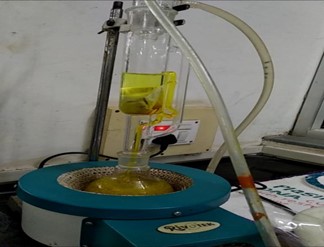
Formulation Table :(1)
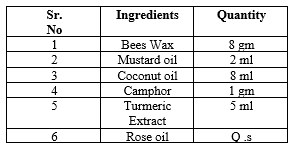
Procedure:
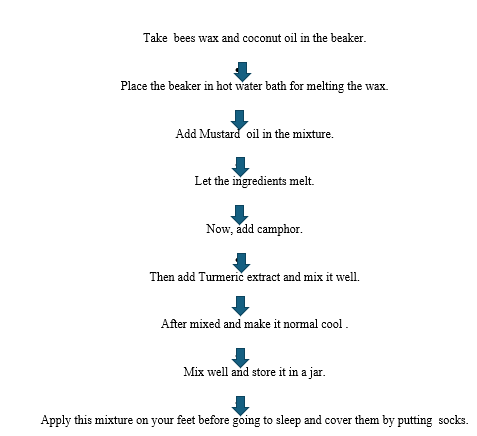
Evaluation :
- Physical appearance:
The physical appearance of the cream can be watched by its colour, harshness and graded.
- Spreadability:
Satisfactory amount of sample is taken between two glass slides and a weight of 100gm is connected on the slides for 5 minutes.[15]
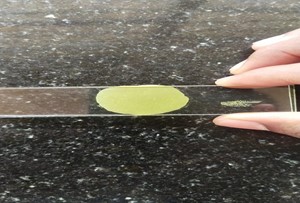
- PH estimation :
The pH of the 10 % w/v cream suspension was decided at 25 °C utilizing a pH meter, standardized utilizing pH 4.0 and 7.0 standard buffers some time recently utilize and normal of triplicates were determined.[16]
- Irritancy :.
Apply the cream to the specified area on the left-hand dorsal surface, ensuring coverage of 1 cm?2;. After application, note the time and monitor the area for any signs of irritation, erythema, or edema for up to 24 hours, recording any observations in detail.
- Washablity:
A little sum of cream was connected on the hand and it is at that point washed with tap water[17]
- Phase separation:
The formulated crack cream was kept intact during a closed container at 25–100 °C, not exposed to light. Phase separation was observed every 24 h for 1 mo. In this crack cream, all formulations shown no phase separation was observed.
- Homogeneity:
The formulation was tested for the homogeneity by visual appearance and by touch.[18]
- Test for microbial growth in formulated:
This technique was applied from the produce of Matangi and Team in the year 2014 also others . Here, Streak Plate Method was used, where the prepared creams were inoculated in a plate with the agar media, and a control was prepared by omitting the cream. Put in the incubator, the plates are incubated for 24 hours at 37° C. Plates were taken out after the incubation time and checked the microbial growth. The objective was to see the product shows result which is not more than 100 Microbial counts, which shows preliminary result that this possesses antimicrobial properties. [19,20,].
OBSERVATION AND RESULT(TABLE 2)
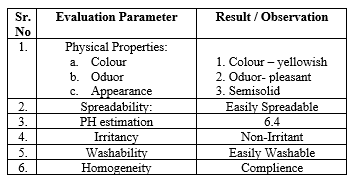
CONCLUSION:
The heel fissures cream we’ve formulated serves to treat and prevent cracked heels, known to cause bacterial, fungal, and other infections. This cream, crafted with mustard oil and turmeric, functions as an anti-inflammatory, analgesic, antimicrobial, antifungal, and antibacterial agent, and turmeric aiding in reducing inflammation, pain, and preventing infections. The ingredients listed in Table 1 were carefully selected and used in appropriate quantities for optimal results. We conducted tests according to the parameters outlined in Table 2 ,and the evaluation results were satisfactory. The cream exhibited stability, post-application feel, lack of irritancy, and good spreadability, indicating its effectiveness.
REFERENCE :
- Seth S.D, Sharma B.,2004, Medicinal plants in India. Indian Journal of Medicina Research,120, 9-11.
- Ayurvedic- Bioline international official site.
- Mukherjee.P.K, 2002, “Quality control of herbal drugsan approach to evaluation of Botanicals”, Business Horison pharmaceutical publication, 1st edition, 708, 709, 791, 742, 3,4,5,7.
- stylecraze.com/articles/simple-home-remedies-for-crackesheels/#gref. [Last accessed on 10 Dec 2019]
- Suh, EJ, Woo YA and Kim, HJ. Determination of Water Content in Skin by using a FT Near Infrared Spectrometer, Arch Pharm Res., 2005; 28(4): 458-462.
- Myers D. Surfactant Science and Technology, 2005:5-14.
- Agrawal S.S, Paridhavi M., 2007, Herbal Drug Technology. Universities Press (India)Private Limited, Hyderabad,225. in dermatology and skin care. Molecules. 2020; 25(3): 556. doi:10.3390/molecules25030556.
- 12Kurek-Górecka A, Górecki M, Rzepecka-Stojko A, Balwierz R, Stojko J. Bee products.
- R. P. Yadav, Bibha Kumari, Ultrasonic Studies on Mustard Oil: A Critical Review, International Journal of Science and Research (IJSR) ISSN (Online): 2319-7064 (2013).
- Bruce Fife .CN.MD.The Coconut Oil Miracle, Avery, USA, 4th edn, 2004; 1-7.
- Yadav Kumar Sandeep,”Medicinal and Cometic uses of Aloe vera”, volu16]
- Epelbaum, R., Schaffer, 7. R. P. Yadav, Bibha Kumari, Ultrasonic Studies on Mustard Oil: A Critical Review, International Journal of Science and Research (IJSR) ISSN (Online): 2319-7064 (2013).
- M., and Vizel, B. (2010). Phase II study of kurkumin and gemcitabine in patients with advanced pancreatic cancer. Nutrition and Cancer. 8. Halaman 1137–1141.
- De Groot, A.C.; Schmidt, E. Essential Oils: Contact Allergy and Chemical Composition; CRC Press: Boca Raton, FL, USA, 2016; p. 1058. [Google Scholar]
- Paramapojn S, Gritsanapan W. Radical scavenging activity determination and quantitative chemical analysis of curcuminoids in Curcuma zedoaria rhizome extracts by HPLC method. Curr Sci. 2009, 97:1069-10107
- Aswal A, Kalra M, Rout A, “Preparation and evaluation of polyherbal cosmetic cream” Der Pharmacia Lettre, 2013; 5(1):838
- Lachman L, Herbert AL, Joseph LK. The theory and practice of industrial pharmacy. Chp III. Varghese Publication House, India; 1999. p. 569.
- Sk Uddandu Saheb, Aduri Prakash Reddy, K Rajitha, B Sravani, B Vanitha. Formulation and evaluation of cream from naturally containing plant extracts. World J Pharm Pharm Sci 2018;7:851-62.
- 18.Aswal A, Kalra M, Rout A, “Preparation and evaluation of polyherbal cosmetic cream” Der Pharmacia Lettre, 2013; 5(1):838.
- Dbase AS, Khadbadi SS, Saboo SS. Formulation and Evaluation of Vanishing Herbal Cream of Crude Drugs. American Journal of Ethnomedicine 2014;1:313
- Matangi SP, Mamidi SA, Gulshan MD, Raghavamma STV, Nadendla RR. Formulation and Evaluation of Anti Aging Poly Herbal Cream. Int J Pharm Sci Rev Res 2014;24:133–6.


 Gadade Pooja * 2
Gadade Pooja * 2







 10.5281/zenodo.11073366
10.5281/zenodo.11073366